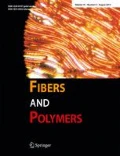Abstract
In this paper, the effects of low temperature plasma (LTP) treatment on the dyeing properties of the wool fiber were studied. The wool fibers were treated with oxygen plasma and three types of dye that commonly used for wool dyeing, namely: (i) acid dye, (ii) chrome dye and (iii) reactive dye, were used in the dyeing process. For acid dyeing, the dyeing rate of the LTP-treated wool fiber was greatly increased but the final dyeing exhaustion equilibrium did not show any significant change. For chrome dyeing, the dyeing rate of the LTP-treated wool fiber was also increased but the final dyeing exhaustion equilibrium was only increased to a small extent. In addition, the rate of afterchroming process was similar to the chrome dyeing process. For the reactive dyeing, the dyeing rate of the LTP-treated wool fiber was greatly increased and also the final dyeing exhaustion equilibrium was increased significantly. As a result, it could conclude that the LTP treatment could improve the dyeing behavior of wool fiber in different dyeing systems.
Similar content being viewed by others
References
C. L. Bird, “The Theory and Practice of Wool Dyeing”, p.8, Society of Dyers and Colourists, Braford, U.K. 1971.
D. M. Lewis, “Wool Dyeing”, pp.5–13, Society of Dyers and Colourists, Bradford, 1992.
J. A. Maclaren and B. Milligan, “Wool Science: The Chemical Reactivity of the Wool Fiber”, pp.5–11, Milligan, Science Press, Marrickville, N.S.W., 1981.
H. Thomas and H. Hocker,Proceedings of the 9th International Wool Textile Research Conference, IV, p.351 (1995).
J. D. Leeder and J. A. Rippon,Proceedings of the International Symp. on Fiber Science and Technology, II, 203 (1985).
C. W. Kan, K. Chan, and C. W. M. Yuen,Fibers and Polymers,5(1), 52 (2004).
H. J. Yan and W. Y. Guo,Proceedings of the Fourth Annual International Conference of Plasma Chemistry and Technology, 181 (1989).
H. Hocker, H. Thomas, A. Kuster, and J. Herrling,Melliand Textilberichte/International Textile Reports,75, E131 (1994).
J. R. Aspaldn,Textile Chemist and Colorist,23(10), 13 (1991).
C. M. Chan, T. M. Ko, and H. Hiraoka,Surface Science Report,24, 1 (1996).
D. M. Lewis, “Wool Dyeing”, pp.224–227, Society of Dyers and Colourists, Bradford, 1992.
Author information
Authors and Affiliations
Corresponding author
Rights and permissions
About this article
Cite this article
Kan, C.W. Dyeing behavior of low temperature plasma treated wool. Fibers Polym 7, 262–269 (2006). https://doi.org/10.1007/BF02875683
Received:
Revised:
Accepted:
Issue Date:
DOI: https://doi.org/10.1007/BF02875683


